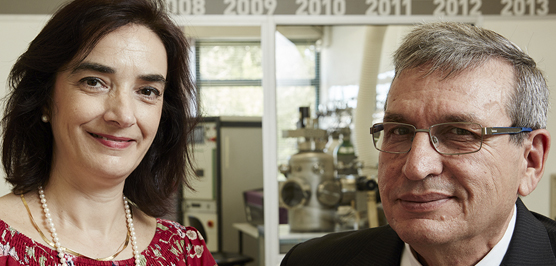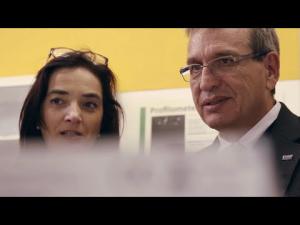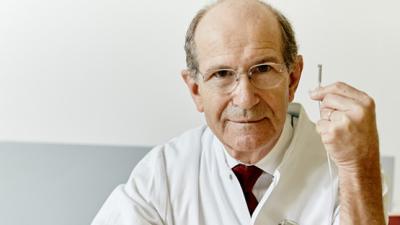Elvira Fortunato, Rodrigo Martins
Paper-based microchips
Finalist for the European Inventor Award 2016
The digital age has been relentlessly eroding the power of paper and print. From newspapers and books to billboards and business cards, silicon is replacing cellulose at breathtaking speeds. Yet it might be too soon to toll paper's death knell. An ingenious paper-based transistor, developed by Elvira Fortunato and Rodrigo Martins, promises to push digital technology into a myriad of new applications. While the technology in its current form is unlikely to do away with the silicon chip entirely, it might be just the key for applications where silicon proves prohibitively costly and wasteful. Its potential uses include radiofrequency identification (RFID) tags in shipping and inventory management, and self-updating plane tickets, business cards and food labels.
Although electrical engineers had already successfully embedded electronics within paper, the team made history as the first to incorporate paper - or scientifically speaking, cellulose - as a functional part of the transistor. This breakthrough was achieved by coating parts of the paper transistor with inorganic oxides, thereby creating the insulating component otherwise manufactured from silicon or other inorganic materials.
Societal benefit
Conventional transistors are made from electronics-grade silicon, the production of which is a wasteful process with significant environmental impact. The process is wasteful because up to 80% of the naturally occurring metallurgical silicon is lost during purification. And the impact is high because of the use of greenhouse gases like sulphur hexafluoride - the most potent greenhouse gas per molecule, a single tonne being equivalent to 25 000 tonnes of CO2.
A switch to paper-based transistors would alleviate the environmental burden of silicon and boost the European cellulose market, which accounts for 30% of the world's total production. The invention of inexpensive paper chips also facilitates expanded use of RFID tags on items like packets of food on supermarket shelves or on shipping containers - thereby preventing exposure to spoiled foods and loss of items in transit - currently thwarted by the high cost of silicon-based RFID chips.
Economic benefit
In 2008, Portuguese augmented reality firm YDreams secured the name Paper-e® for Fortunato's paper transistors as a trade mark valid in 14 countries. Founded in 2000 as a spin‑off company from the New University of Lisbon, YDreams is headquartered in Lisbon but also has offices in Austin, US, and Rio de Janeiro, Brazil, with 120 employees worldwide. The company currently produces product prototypes of the paper chip technology, including a self‑updating airplane ticket, and is working on market entry with official funding: Fortunato's work on inorganic oxides in electronics was singled out by the European Research Council for a EUR 2.5 million grant - the largest awarded to a Portuguese scientist to date.
In the near future, the most promising area for cellulose-based transistors is in the electronic smart packaging market. According to an IDTechEx report the global demand in this field will grow rapidly from EUR 26 million (USD 30 million) in 2012 to EUR 1.51 (USD 1.7 billion) by 2022.
Yet, disposable, paper-based microelectronics hold the potential to create a new category on the lucrative global transistors marketplace. In 2014, Research and Markets estimated the combined market size of insulated-gate bipolar transistors (IGBTs) and metal-oxide field-effect transistors (MOSFETs) at EUR 4.21 billion (USD 4.785 billion). The market is expected to grow at a compound annual rate of 11.7% to more than EUR 10.56 billion (USD 12 billion) by 2021.
How it works
In a conventional transistor, silicon serves two functions: firstly, doped with small amounts of other chemicals, it acts as a semiconductor to conduct the flow of electrons; secondly, especially when heated to create silicon dioxide, it acts as a dielectric or insulator and can be used to store and block current. Both components are needed to create a fully-fledged transistor, and previous to Fortunato's invention, paper-based semiconductors appeared impossible.
The invention solves the problem by coating paper sheets with semiconductors made of oxides of zinc, gallium and indium, which are then connected through a layer of aluminium. As a consequence of the coating, the paper becomes not only the substrate of the transistor, but also the dielectric layer - its insulating component. The resulting "paper transistor" is not only inexpensive and energy-saving, but also fully recyclable. Because the materials can be processed at room temperature, instead of at the hundreds of degrees normally required by silicon, production requires significantly less energy.
The inventors
A childhood fan of the science fiction sagas of Jules Verne, Elvira Fortunato already began exploring the world of microelectronics while studying for her Materials Science and Physics diploma at the New University of Lisbon (UNL) in 1987. After joining the Materials Research Centre (CENIMAT) at UNL as a director in 1998, she focused on applications of inorganic oxides in electronics, a field in which she now ranks among the top pioneers.
During a research career in microelectronics spanning more than 30 years, Fortunato has worked on 7 granted and 50 pending patents. Having published more than 500 papers during the last 10 years, she is an advocate of bridging the gap between research and industry.
Currently the director of the Institute of Nanomaterials, Nanofabrication and Nanomodeling at CENIMAT, Fortunato has been recognised with distinctions including the IDTechEx Printed Electronics Academic R&D award in the US (2009), and the European Women's Innovation Prize in Finland (2011). In 2010, she was honoured with the grade of Grand Officer of the Order of Prince Henry the Navigator by the President of the Republic of Portugal.
Did you know?
Paper is not only the stuff on which bank notes are printed, but also an extremely lucrative market: in 2014, the global paper, plastics, rubber, wood and textile manufacturing sector was worth EUR 4.95 billion (USD 5.45 billion) - a whopping 7.2% of the global economy that year.
Beyond printed matter, paper is currently a trending new material in applications such as "bioplastics". These organic polymers are entirely natural, fully compostable building components for a new generation of consumer products, including loudspeakers and guitars. Marketed under the name Arboform, bioplastics won the European Inventor Award in 2010. Which begs the question: will paper be on the EIA podium once again in 2016?
Media gallery
Contact
European Inventor Award and Young Inventors Prize queries:
european-inventor@epo.org Subscribe to the European Inventor Award newsletterMedia-related queries:
Contact our Press team#InventorAward #YoungInventors










